Kerala
Music
Introduction
The Music of Kerala has a long and rich history. It is not the same as Malayalam poetry although most of it is poetry driven. Kerala has a rich tradition in Carnatic music . The significance of music in the culture of Kerala can be established just by the fact that in Malayalam language, musical poetry was developed long before prose. With the development of music in the region, different branches were formed out of it. The most basic branches are classical music which is primarily Carnatic music oriented, and popular music which includes film songs and album songs. Then there is music like chenda melam which is quite popular.
Classical Music
Keraḷa is musically known for Sopānam . Sopānam is religious in nature, and developed through singing invocatory songs inside temples. Sopānam came to prominence in the wake of the increasing popularity of Jayadheva 's Gītha Govindha or Aṣhṭapadhis . Sopāna sangītham (music), as the very name suggests, is sung by the side of the holy steps (sopānam) leading to the sanctum sanctorum of a shrine .
- Sopānam Sangitham

Some famous sopānam singers are Neralattu Rāma Poduvāḷ Janārdhanan Neḍungadi and Dhāmodhara Mārar.
Legends like Swāthi Thirunāḷ, Ṣhadkalā Govindha Mārar, Chembai Vaidyanātha Bhāgavatar , Yesudhās(Jesudhās), Pālghāt Maṇi Iyer , Vidhwān Gopāla Piḷḷai, Chertala Gopālan Nair, M . D . Ramanathan , T . V . Gopalakrishnan , Śhankaran Nambūthiri and T . N . Krishnan are renowned musical exponents from Keraḷa.
Other styles :
Kathakaḷi Music
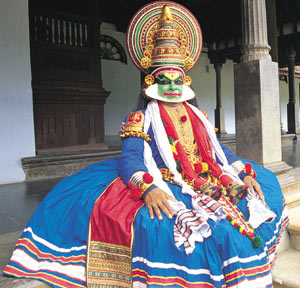
Puḷḷuvan Pāttu
The puḷḷuvar of Keraḷa are closely connected to the serpent worship. One group among these people consider the snake gods as their presiding deity and perform certain sacrifices and sing songs. This is called Puḷluvan Pāttu. The song conducted by the puḷḷuvar in serpent temples and snake groves is called Sarppapāttu, Nāgam Pāttu, Sarpam Thuḷḷal , Sarppolsavam, Pāmbum Thuḷḷal or Pāmbum Kālam. The main aspects of this are Kaḷamezhuthu (Drawing of Kaḷam, a ritual art by itself), song and dance.
Oṭṭamthuḷḷal Songs
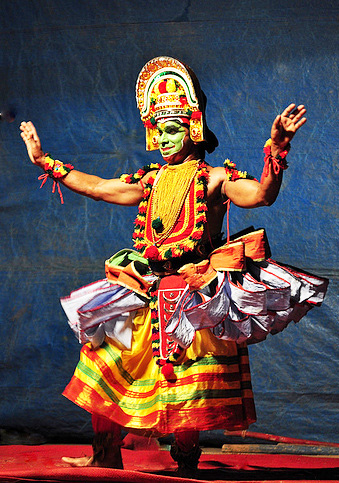
Folk Songs
Keraḷa is very rich in its folk song tradition and has many varying folk songs as there are there are variances in the climate, land, people and their occupations.
The nāḍanpāṭṭu (nāḍan-native, pāṭṭu-songs) of Keraḷa or Keraḷa folk songs narrate unrecorded tales of the land and people. These lyrical songs are evoked from the emotions and simple wisdom of agrestic folk. Almost every aspect of life and occasions such as childbirth marriage, festivals, the glee of the harvest season, weddings, war, the union of man and woman, mythology and religion and death finds a place in Keraḷa folksongs.
Māppilapāṭṭukaḷ, Paḷḷipāṭṭukal, Ōṇapāṭṭukaḷ, Mappiḷapāṭṭu, Vilpāṭṭu and Vanchipāṭṭukal, are some of these native songs of different castes and communities of Keraḷa.
Instrumental music
The instrumental music of Keraḷa is dramatic and lively with a large number of musical instruments such as Chenḍa, Dolak, Eḍakka, Mizhavu, Mrudhangam, Udukku, Takil and Timila and a few percussion instruments. Wind instruments include Kombu, Kuzhal, Nādhaswaram and Mughavīṇā and so on. The varied stringed instruments include Thambhuru, Sārangi, Swarabi, Vīṇā and Violin. The Chenḍameḷam has become an inseparable part of all the temple festivals of Keraḷa. 'Thayampaka' is another unique temple vādhya.
- Mizhavu or Mizhav is a large drum made of copper or clay and is played as an accompanying percussion instrument in the famous ceremonial temple performances of Keraḷa- Kūthu and Kūḍiyāṭṭam .It resembles a big jar and has a narrow mouth with a leather covering. This musical instrument is solely played with hands. Only the traditional Ambalavāsi Nambiār community, Chākkiyār and the Nangiārs were entitled to play the Mizhavu inside the temples or Kūthambalams. The reverberating beat of the Mizhavu is still unparalleled when compared with the sonata of other percussion instruments.
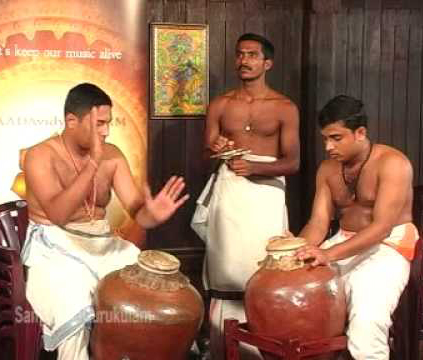
- Panchavādhyam
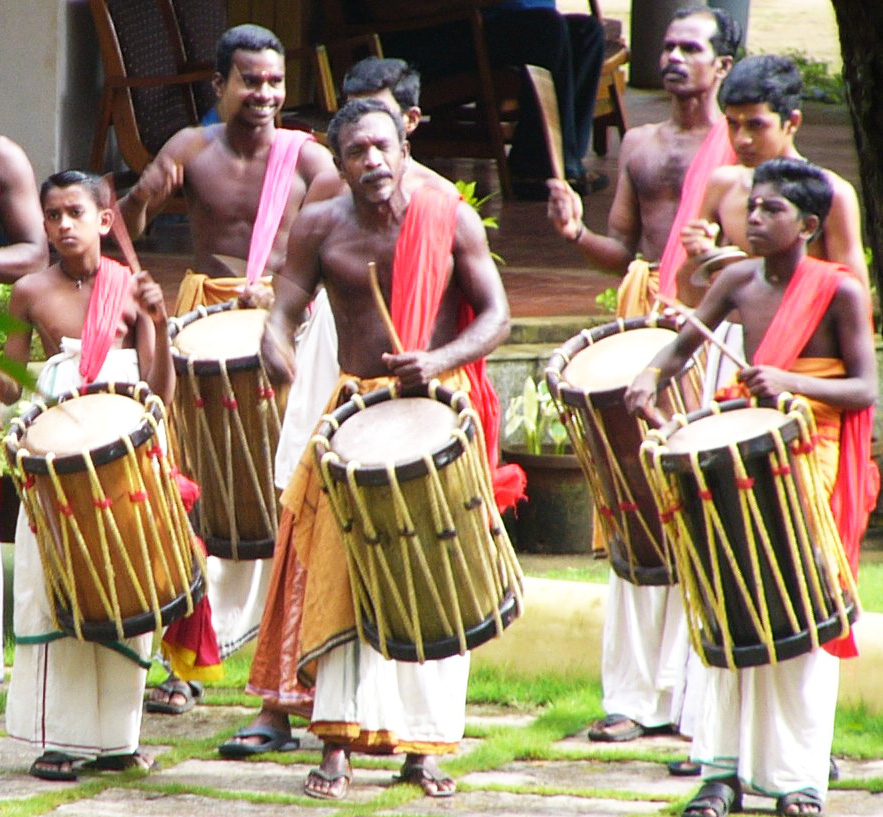
Panchavādhyam is a classical performance of various musical instruments that are endemic to Keraḷa. As the term “pancha” in Sanskrit means five, Panchavādhyam consists of five percussion instruments- Idakka, Elathāḷam, Kombu, Shuddha Maddhalam and Timila. Edakka, Shuddha Maddhalam and Timila are different kind of drums while Elathāḷam is a cymbal and the Kombu is a kind of trumpet. Altogether symphony of these five musical instruments captivates the listeners. The performance of Panchavādhyam is an integral part of the festivals of the Temples in Keraḷa, especially in Central Keraḷa.
Church Choir
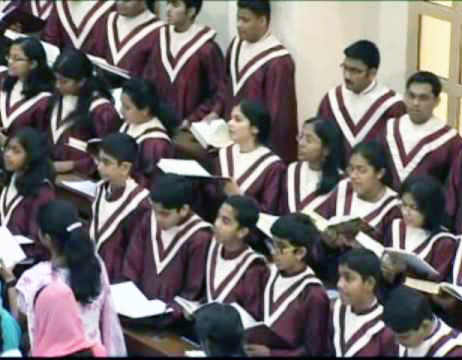
Māppiḷa Pāttu
The Malabar region of the state, with a large Muslim population had developed a signature music stream based on the Hindusthāni style. The stream consists of a variety of forms like ghazals and māppila pāṭṭu, and also music for authentic Muslim dance forms such as oppana and kol kaḷi. The poetry forms a main part of this stream of music, which is primarily in Maḷayāḷam with the use of Arabic words in between which is known as ArabiMaḷayāḷam. Māppila songs have a charm of their own as their tunes sound a mix of the ethos and culture of Keraḷa as well as West Asia. They deal with diverse themes such as religion, love, satire and heroism.
Popular music
Popular music of Keraḷa had a linear development along with classical music of the region, till the branches separated. The popular music in Keraḷa is enriched by its highly developed film music branch. Other forms of popular music include light music , albums otherwise known as Mallu Pop. Devotional songs also constitute a major part of Maḷayāḷam popular music.
- Maḷayāḷam film music
Film music , which refers to playback singing in the context of Indian music , forms the most important canon of popular music in India. Film music of Keraḷa in particular is the most popular form of music in the state. Before Maḷayāḷam cinema and Maḷayāḷam film music developed, the Keraḷites eagerly followed Tamil and Hindi film songs and that habit has stayed with them till now. The history of Maḷayāḷam film songs begin with the 1948 film Nirmala. The film's music director was P.S. Dhivākar and the songs were sung by P.Līlā, T. K. Govindha Rao, Vāsudeva Kurup, C. K. Rāghavan, Sarojini Menon and Vimala B. Varma, who is credited as the first playback singer of Maḷayāḷam cinema.
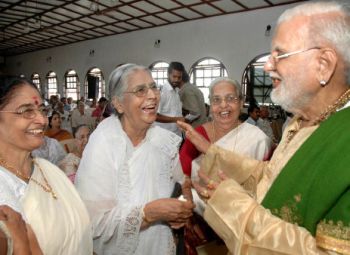

The male singers who got national award are K . J . Yesudhās (1973, 1974, 1988, 1992, 1994), P . Jayachandran (1986) and M . G . Srīkumar (1991, 2000). Yesudhās has won two more national awards for singing in Hindi (1977) and Telugu (1983) films, which makes him the person who has won the largest number of National Film Award for Best Male Playback Singer with 7 awards, closely trailed by S . P . Bālasubramaṇiam with 6 awards.
The female singers who have won the award are S . Jānaki (1981) and ā (1987, 1989). Chitrā had also won the award for Tamil (1986, 1997, 2005) and Hindi (1998) film songs, which makes her the person with the largest number of National Film Award for Best Female Playback Singer wins with 6 awards, closely trailed by P.Sushīlā with 5 awards.
Maḷayāḷam Pop music
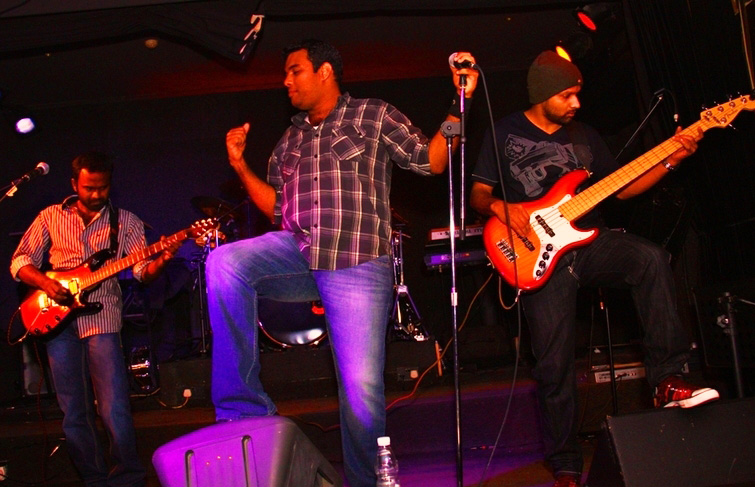
Meanwhile Pop albums had caught up the imagination of college campuses and more talents started to come up with music albums. One of such early albums that had become a rage with the youth of that time was Valentine's Day. The song "Niranja Mizhiyum" from the album composed by Isaac Thomas Kottukappally and penned down by Girīsh Puthanchery had become a big hit in college campuses. Audio companies other than East Coast started to come up with Music Albums. Front runners among them were Johny Sāgarika, Sathyam Audios, Magnum audios and Octave audios. As a result Pop music culture grew in Keraḷa. After a gap of 6 years, East Coast came up with their 6th album in Ninakkai series, a very ambitious project 'Ennennum'. The album was released in 5 languages in India with 60 songs involving 30 leading singers in the country. This magnum opus album was composed by Vijay Karun and penned down by East Coast Vijayan. It can be regarded as the first big budget music album of Keraḷa. Talented young composers like Rāshī (Alone, Loved and Lost), Dijo Jose Antony (La Cochin), Nithin (Autograph), Mithun Rāj(Violet)have also created their marks in the Maḷayāḷam album industry.
Dance
Introduction
There are 50 folk dances in Keraḷa, the popular ones are Kaḷiyattom, Kolam Thuḷḷal, Kolkaḷi, Veḷakaḷi and Kaikoṭṭikaḷi. All these are performed in accompaniment of songs and drumming and often in colourful ornamental costumes. From these arose Keraḷa's classical dances like Kūthu, Kathakaḷi, Mohiniāṭṭam and Patokom. Kathakaḷi uses vivid and eloquent mudhrās (hand signs). A visually powerful art form, the Kathakaḷi dance dramas are based on stories from the two great Indian epics - the Rāmāyaṇa and the Mahābhāratha. It is said to have evolved from a rivalry between two princely families. One had written a story cycle revolving around the life of Krishṇa, called Kriṣhṇanāṭṭam, the other around the life of Rāmā called Rāmanāṭṭam. Mohini āṭṭam, which literally means "the dance of the enchantress", is sensuous and lyrical. Dancers display grace as well as passion
Mohiniyāṭṭam

The theme of Mohiniyāṭṭam is love and devotion to god. Viṣhṇu or Kriṣhṇa is more often the hero. The spectators could feel his invisible presence when the heroine or her maid details dreams and ambitions through the circular movements, delicate fūtsteps and subtle expressions. The dancer in the slow and medium tempos is able to find adequate space for improvisations and suggestive bhāvas. In format, this is similar to Bharathanātyam. The movements are graceful like Oḍissi and the costumes sober and attractive. It is essentially a solo dance, but in present times it is performed in groups also. The repertoire of Mohiniyāṭṭam follows closely that of Bharathanātyam. Beginning with Cholkeṭṭu, the dancer performs Jathiswaram, Varṇam, Padham and Thillāna in a concert. Varṇam combines pure and expressional dance, while Padham tests the histrionic talent of a dancer and Thillana exposes her technical artistry.
Popular dance forms
Thiruvāthirakaḷi

Thiruvāthirakaḷi or Kaikottikaḷi is a popular dance form of the women folk of Keraḷa. In this, eight to ten girls perform forming a circle by themselves. They sing and dance to the rhythm of clapping hands. Well-versed padams of Kathakaḷi and Mohiniyāṭṭam come alive in Thiruvāthirakaḷi with a folk accent. The music and movements of Thiruvāthirakaḷi has a native simplicity and lyrical grace. This graceful systematic group dance is performed on festivals like Oṇam and Thiruvāthira.
The dominant sentiment of this rustic dance is unalloyed joy. The footwork and movements of this form have grown naturally from the grace, simplicity, dignity, boldness, sense of beauty and such other qualities that are abundant in the woman of Keraḷa. This dance form has an amazing lāsya charm redolent of devotion and erotic sentiment. Moving in circle, clock wise and anti clock wise, the dancers bend sideways also for clapping together in beautiful gestures. The songs of the dance have sprung up from the everyday life of rustic generation, particularly from the simple amusement of women folk. For this reason, their tunes and rhythm are closely associated with the social life and natural beauty of Keraḷa. Some other forms are also prevalent of this folk dance known as kolāṭṭam and Kummi.
Thuḷḷal
Thuḷḷal, the dance form of Keraḷa is yet another gem in the vast repertoire of Keraḷa's performing arts. It has from its very inception, enjoyed a ready appeal with both the commoner and the connoisseur for unlike forms such as Kūdiyāṭṭam, Kriṣhṇanāṭṭam, Kathakaḷi and Mohiniyāṭṭam, it requires no initiation to intelligently respond to it. One can easily react and enjoy Thuḷḷal without any prior exposure or sophisticated understanding. As this is composed in the language of the layman, it is known as the 'poor man's Kathakali'
The word Thuḷḷal belongs to the Dravidian family of languages and literally means 'jumping', this however can be extended to mean 'to leap about' or to 'cut a caper'. Thullal presentation generally lasts two hours and are rendered at a pitch and pace that keep onlookers thoroughly gripped. The dancer dances and sings simultaneously and this entails a long period of rigorous training, an agile body and a communicative voice. The dancer must also be gifted with a sharp memory, for he must remember long poems some of which have over 1000 couplets. The emotions pertain mainly to valour, humour, pathos, anger and devotion. Śhrungāra, the erotic element, is virtually absent, but is rarely missed, for the burden of the songs and the nature of the dance are hardly conducive to tender passions.
In make-up and costumes, Thuḷḷal has the traces of colour and the gorgeousness of Kathakaḷi. The face is painted with yellow arsenic mixed with blue. The eyes are blackened and lips reddened. The dancer wears a breast-plate adorned with golden pearls, necklaces and colourful tassels. The white waist clothes resemble skirts. The head-gear is small, made of light wood, studded with bright stones and decorated with golden paper. The bracelets, amulets and waist lets are almost the same as in Kathakaḷi.
Thuḷḷal is of three kinds: Oṭṭan, Parayan and Sīthangan. The distinction between them lies mostly in the make-up and costumes and to some extend in meters and rāgas of the text. Of these, Oṭṭan Thuḷḷal is the most popular.
- Oṭṭanthuḷḷal
A solo dance exposition, the Thullal is of three types. Its origin is attributed to Kunchan Nambiar, a veritable genius and one of the foremost poets of Keraḷa. Though based on classic principles of Natya Shastra the technique of this art is not rigid. The songs, written in simple Maḷayāḷam, frank outspoken wit and humour, the simplicity of presentation and the direct appeal to every day life made Thullal very popular.
Kolkaḷi
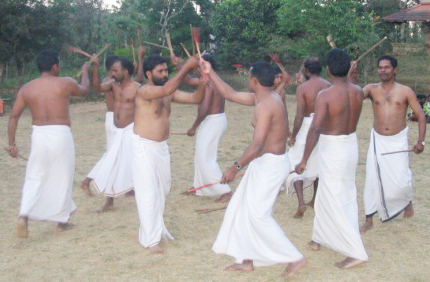
Ritual dance forms
Theyyam
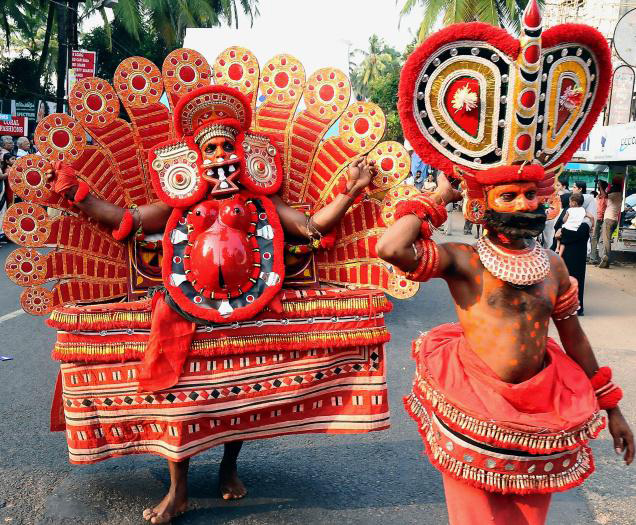
Mudiyeṭṭu

Thīyyāttu
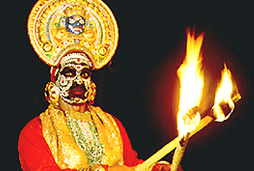
Community dance forms
Vaṭṭakaḷi
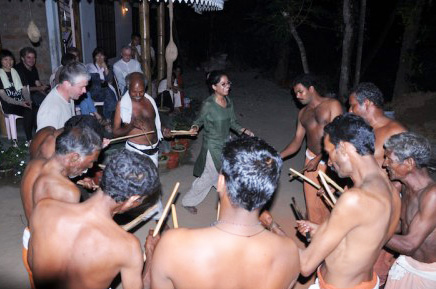
Oppana
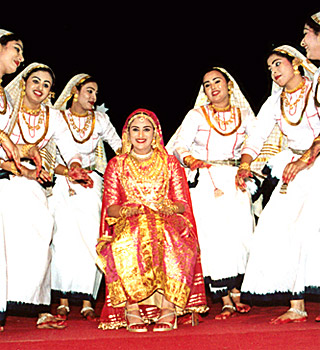
Mārgamkaḷi

Theatre (Dance Dramas)
Chākyārkūthu
.jpg)
Kūḍiyāṭṭam
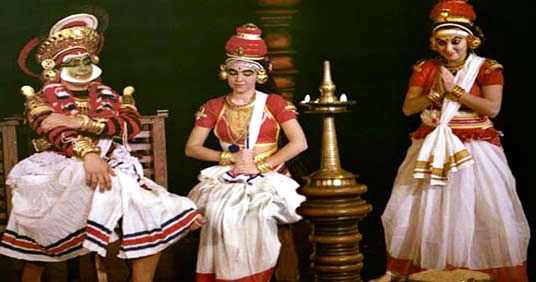
Kathakaḷi

Kathakaḷi draws heavily from drama and is danced with elaborate masks and costumes. Kathakaḷi recitals are generally long and while other dance forms are more emotive than narrative, Kathakaḷi is both. It combines dance with dialogue to bring myth and legend to life in the temple courtyards of Keraḷa. The dancers use their stunning costumes and make-up, with the accompaniment of drums and vocalists, to create various moods and emotions. So strong is the identification of the dancers with the characters they play and so absolute their conviction, that they seem to surpass themselves, becoming one with the legendary heroes and heroines they depict.
Present day Kathakaḷi is a dance drama tradition, which evolved from centuries of highly stylized theatrical traditions of Keraḷa, especially Kūdiyāṭṭam. Ritual traditions like Theyyams, Mudiyāṭṭam and the martial arts of Keraḷa played a major role in shaping the dance into its present form. The great poet Vaḷḷathol rediscovered Kathakaḷi, establishing the Keraḷa Kalāmandaḷam in 1932 which lent a new dimension to the art-form.
Fusion dance form
Chaviṭṭunātakam
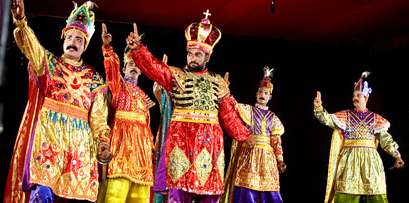
Martial art and Dance
Kaḷaripayaṭṭu
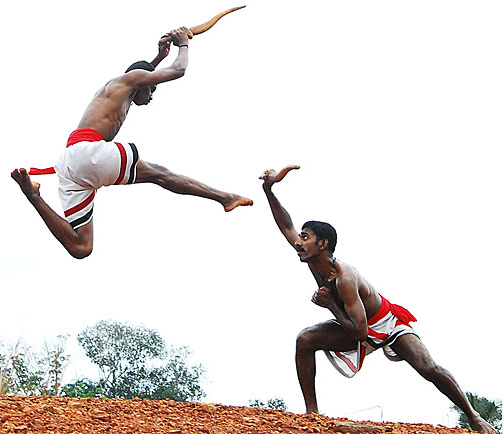
- Styles of Kalaripayaṭṭu
- Northern Kaḷaripayaṭṭu places comparatively more emphasis on weapons than on empty hands.
- Southern Kaḷaripayaṭṭu is a style of kalaripayaṭṭu, practice and fighting techniques emphasize empty hands.
- The central style is a combination of northern and southern styles that includes northern meipayaṭṭu preliminary exercises.
Veḷa Kaḷi
A martial dance of the Nair community. This depicts ancient warfare in Keraḷa in all its ferocity and valour. Armed with shining swords and shields in exotic costumes they dance with vigour and force. The dance ends with the victory of good over evil.
Bibliography
http://en.wikipedia.org/wiki/Malayalam
http://www.chintha.com/keralam/malayalam/language-history.html
http://www.esamskriti.com/essay-chapters/History of Malayalam-1.aspx
http://www.lisindia.net/Malayalam/Malay_hist.html














